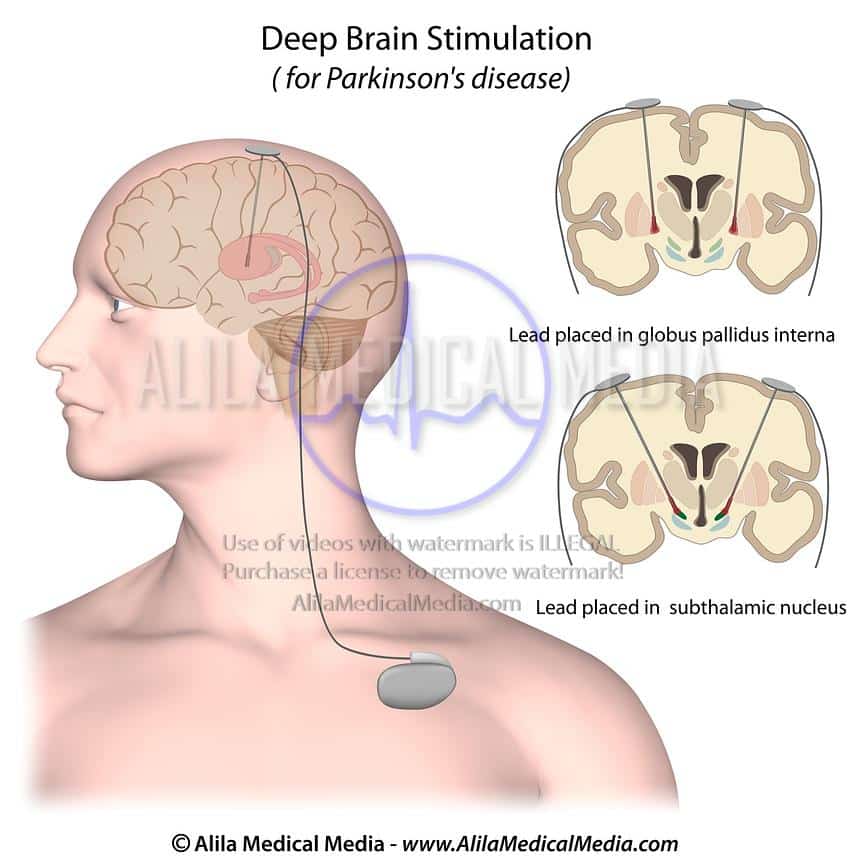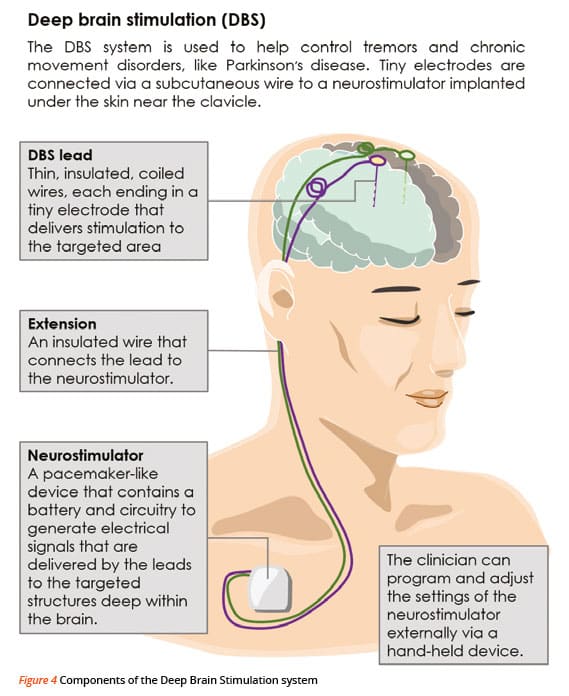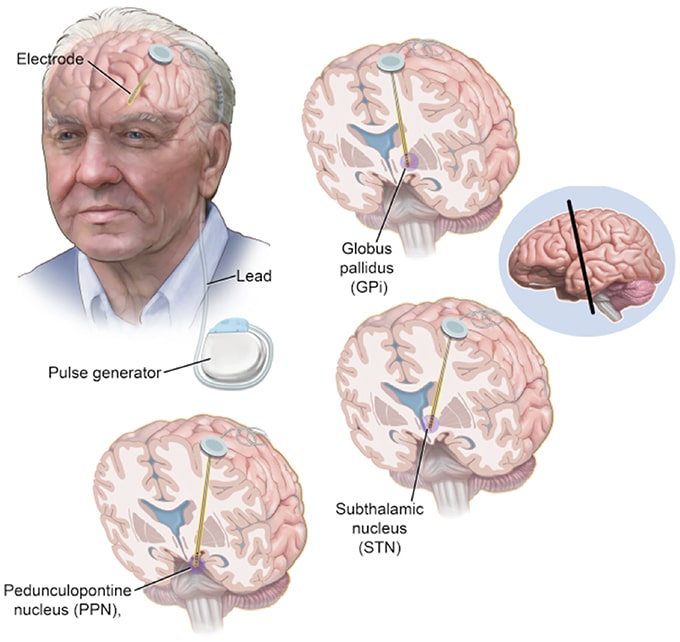What Happens Before Surgery
In the doctors office you will sign consent forms and complete paperwork to inform the surgeon about your medical history, including allergies, medicines, anesthesia reactions, and previous surgeries. Presurgical tests may need to be done several days before surgery. Consult your primary care physician about stopping certain medications and ensure you are cleared for surgery.You may also need clearance from your cardiologist if you have a history of heart conditions.
Stop taking all non-steroidal anti-inflammatory medicines and blood thinners 7 days before surgery. Stop using nicotine and drinking alcohol 1 week before and 2 weeks after surgery to avoid bleeding and healing problems.
You may be asked to wash your skin and hair with Hibiclens or Dial soap before surgery. It kills bacteria and reduces surgical site infections.
No food or drink, including your Parkinsons medication, is permitted after midnight the night before surgery.
Try to get a good nights sleep. The DBS surgery involves multiple steps and lasts most of the day, during which you may be awake and off medication.
Morning of surgery
Arrive at the hospital 2 hours before your scheduled surgery time to complete the necessary paperwork and pre-procedure work-ups. An anesthesiologist will talk with you and explain the effects of anesthesia and its risks.
Consult With A Neurologist And A Neuropsychologist
After learning more about DBS, the next step is to make an appointment at a center that specializes in the surgical treatment of Parkinson’s. It is important that anyone considering this surgery be evaluated by a neurologist who is familiar with the procedure, expected benefits and potential risks. If a neurologist thinks you are a good candidate for surgery, and you decide to proceed, meet the neurosurgeon to learn more and prepare for surgery.
Neuropsychological testing is also strongly recommended before proceeding with DBS. This test is often standard to ensure DBS is a good option and help determine how it could affect memory and thinking. DBS will not improve or worsen non-motor symptoms associated with Parkinson’s.
What Are The Benefits
- Symptom reduction: DBS often reduces symptoms significantly. These include motor symptoms like stiffness, tremor, slowness and dyskinesia. DBS has also been shown to aid in on/off fluctuations, improve mood and quality of life, and increase overall energy level.
- Little to no damage: In contrast to previous methods, DBS does not damage portions of the brain, nor remove nerve cells.
- Utilizing DBS in addition to levodopa could decrease a persons need for medication, thus, decreasing medication access and cost issues, as well as levodopa side effects.
- Individualized treatment: Electrodes and stimulation frequency and intensity can be controlled by physicians and the individual with DBS, and can be subjectively altered when needed.
Also Check: Life Expectancy With Parkinson’s And Dementia
Thanks For Signing Up
We are proud to have you as a part of our community. To ensure you receive the latest Parkinsons news, research updates and more, please check your email for a message from us. If you do not see our email, it may be in your spam folder. Just mark as not spam and you should receive our emails as expected.
Who Is A Candidate For Deep Brain Stimulation

DBS is more than just a surgical procedure. It involves a series of evaluations, procedures, and consultations before and after the actual operation, so people interested in being treated with DBS should be prepared to commit time to the process.
For example, those who do not live close to a medical center that offers DBS surgery may need to spend significant time traveling back and forth to appointments.
The procedure, as well as the pre-operative evaluation and post-operative follow-up, can be expensive depending on the persons insurance coverage. DBS surgery is an FDA-approved treatment for Parkinsons disease, and Medicare and most private insurers cover the procedure, but the extent of coverage will depend on each persons individual policy.
Prospective patients should have realistic expectations about DBS results. Although DBS can improve movement symptoms of Parkinsons disease and greatly improve quality of life in properly selected patients, it is not likely to return anyone to perfect health.
You May Like: Substantia Nigra And Parkinson’s Disease
What Is The Recovery Time
Your healthcare provider is the best person to tell you what to expect regarding your recovery time and when you will notice changes in your symptoms and how you feel. They can tell you the likely recovery time you’ll need, which can vary depending on other factors like your overall health, other conditions you have and your personal circumstances.
Most people will need to stay in the hospital for one day after surgery to implant the DBS leads in their brain. Surgery to implant the pulse generator is usually a procedure where you go home the same day.
Overall, recovery time generally takes several weeks. Your healthcare provider will likely have you do the following:
- Avoid any kind of activity for about two weeks after each procedure: This includes things as minor as household chores or sexual activity. You should not lift anything heavier than 5 pounds .
- Avoid moderate- or high-intensity activity for at least four to six weeks: This includes exercise and physical labor. Most people can return to work or their usual routine after this.
- Use caution when moving or stretching: You should avoid making certain movements, like raising your hands over your head, for several days after surgery to implant the pulse generator. Your healthcare provider will tell you how long youll need to restrict your movements.
How should I care for the surgical area once I’m home?
Similar Articles Being Viewed By Others
Carousel with three slides shown at a time. Use the Previous and Next buttons to navigate three slides at a time, or the slide dot buttons at the end to jump three slides at a time.
06 September 2021
M. Lenard Lachenmayer, Melina Mürset, Paul Krack
21 August 2019
Abteen Mostofi, Julian M. Evans, Monty A. Silverdale
27 September 2018
Dongning Su, Huimin Chen, Tao Feng
volume 8, Article number: 144
Don’t Miss: Ways To Prevent Parkinson’s
Algorithm Inputs And Burden
Based on the baseline scores assessed at the preliminary assessment phase of the study visit, 3.0 IQR 3.0|3.5 symptoms were selected per hemisphere to generate the total weighted score. From those symptoms, 2.0 IQR 2.0|2.5 were manually assessed by the clinician and 1.0 IQR 1.0|1.0 by the sensor. Upper limb rigidity was always scored, 2.0 IQR 1.0|2.0 symptoms were bradykinesia related and 0.0 IQR 0.0|1.0 symptoms were tremor related.
Clinical responses to the tested DBS settings were variable among the assessed symptoms . For 19 hemispheres, AgP DBS settings leading to the best scores for the combined, total weighted score differed to the DBS settings leading to the best scores for the individual, single symptoms . These differences comprised discrepancies in the suggested stimulation amplitude , in the electrode configuration or in both parameters .
Fig. 1: Exemplary score maps showing responses to AgP DBS settings for subjects 0309-010 right body side symptoms .
Score maps were generated for the A ring and B directional mode stages. Dashed lines on the ring mode stage score maps indicate the level at which the directional mode stage was performed. Red colored areas represent high symptom load and less DBS efficacy, whereas dark green colored areas low symptom load and high DBS efficacy. Note that score maps differed slightly between individual symptoms.
How Can Parkinsons New Zealand Help
Parkinson’s New Zealand offers information and professional support to people living with Parkinsons. Our team of Parkinsons Community Educators can provide home visits for personalised sessions.
Community Educators work closely with the person with Parkinsons and their carers to develop a medical plan that upholds their health and lifestyle. Community Educators liaise with health professionals that treat Parkinsons in the community, including speech-language therapists, occupational therapists, and physiotherapists.
Parkinsons New Zealand also has support groups for members for sharing their coping strategies, experiences, and is a chance to establish social networks. Programs for people with Parkinsons include exercise, physiotherapy, hydrotherapy, and art or music therapy sessions.
Don’t Miss: Stem Cells For Parkinson’s Disease Therapy
Issues With Spatial Analyses And Improvement Maps
The PSA is a small area where slight changes to stimulation parameters or electrode positioning theoretically may affect different structures. Since the zona incerta can be considered as a central hub, with wide connections to various brain areas , different pathways may be stimulated with the possibility to affect different PD symptoms.
Several other studies have used electric field simulation as input for creating probabilistic improvement maps and in some cases also prediction analysis . This was not addressed in this study due to the low level of significance in the statistical test, but the result can be seen as a spatial visualization of the improvement in the cohort. To further elucidate the improvement of different PD symptoms, data from monopolar review would give more spatial information and smaller fields in comparison to more complicated settings like double monopolar stimulation. The downside however is that one only sees the acute effects of stimulation and has lower external validity than chronic stimulation parameters.
You May Like: Nocturnal Leg Cramps Parkinsons
Deep Brain Stimulation Doctors
Our expert restorative neurosurgeon Dr. JP Langevin has many years of experience with DBS. He was the first to implant and program PerceptTM PC with BrainSenseTM technology DBS system to treat patients with Parkinsons disease among Providence hospitals, the 3rd largest healthcare system in the United States.
Read Also: What Causes Tremors Besides Parkinsons
Don’t Miss: Parkinson’s Phase 3 Trials
What Is Deep Brain Stimulation
DBS is a surgical procedure in which thin electrodes are implanted into parts of the brain that control movement. The electrodes deliver tiny electrical pulses to these brain regions. This allows the brain to maintain normal movement activity with a lower dose of levodopa. The electrodes are connected by a wire to a pulse generator that is implanted under the skin in the chest. The electrodes and the wire are also under the skin, so that no part is visible externally.
Effect On Motor Symptoms

Before surgery, the motor symptoms were significantly reduced by 52% by medication . STNDBS significantly reduced UPDRS III by 61% when comparing the OFF/off and the ON/off conditions 1 year after surgery and significantly by 39% at the longterm followup 8 to 15years after surgery .
Medicine significantly reduced motor symptoms further when added to the DBS treatment. The effect of both STNDBS and medicine was a reduction of motor symptoms by 69% 1 year after surgery , and by 51% at the longterm followup compared with the OFF/off condition .
Dont Miss: Apathy In Parkinsons Disease
You May Like: Parkinson’s Doctors In My Area
Are You A Good Candidate For Dbs
The best candidates for DBS surgery are people who:
- Have been diagnosed with Parkinson’s for five years or more
- Have disabling tremors and dyskinesias or severe motor fluctuations
- Experience severe motor fluctuations that cannot be controlled with adjustments to medication schedules
- Often experience significant dyskinesias interspersed with rapids wearing off and off time crises throughout the day
Not everyone is a good candidate for this surgery. It is important to know that some Parkinson’s symptoms respond well to DBS and others do not. The decision to undergo surgery depends on a critical assessment of each person’s specific symptoms.
Symptoms that respond well to intervention include:
- Dystonia (sustained or repetitive muscle twisting, spasm or cramp
Several factors influence the outcome of DBS. One of the best forecasts is your response to levodopa. People whose symptoms still respond well to individual doses of the drug and who have mobility during their “on” periods usually have better results with DBS.
While some people think DBS should not be considered until Parkinson’s medications have become completely ineffective, this is not true. When medications stop working completely, deep brain stimulation won’t work, either. Surgery promises more effectiveness for those who experience complications with medications, such as dyskinesias, but continue to respond well to levodopa.
Those who respond well to DBS tend to be people who:
What Would Happen If I Have Dbs
The duration and surgical steps may vary depending on the type of system used but typically, surgery to implant the DBS system lasts several hours. Your hospital stay is usually a few days and includes a pre-operative assessment, the surgery itself and initial healing before you return home.
Your surgical team will include a neurologist, a DBS specialist neurosurgeon, an anaesthetist, a radiologist and other healthcare professionals.
The components of a DBS system are:
- Neurostimulator this pacemaker-like device is the power source for the system. There are several rechargeable and non-rechargeable stimulators. Each contains a small battery and a computer chip programmed to send electrical pulses to control Parkinsons symptoms.
- Lead an insulated wire terminating in four electrodes which transfer electrical current to your brain .
- Extension an insulated wire placed under your scalp and outside your skull to connect to the lead and run behind the ear, down the neck, and into the chest below the collar- bone where it connects to the neurostimulator.
- Programmer the doctor uses this external programmer to set the parameters for stimulation. Each person responds to DBS in their own way so the programmer will be used to customise the signals to your brain.
- Patient controller in some DBS systems you can use this to turn the neurostimulator on and off. It may also be used to adjust stimulation settings within the limits set by your doctor.
Recommended Reading: What Is An Essential Tremor Parkinson
What Is The Success Rate Of Deep Brain Stimulation
In general, deep brain stimulation is usually successful. The success rate depends on the condition involved. For conditions like epilepsy and Parkinsons disease, DBS is very effective. More research is necessary for conditions where DBS is experimental before experts know if DBS is likely to help.
Also Check: Does Parkinsons Disease Affect The Brain
Seven Steps To Deciding If Dbs Is For You
Printing made possible with an educational grant from Medtronic. Content created independently by the Parkinsons Foundation.
Read Also: Nasal Spray For Parkinson’s
Mechanism Of Action Of Dbs
Current hypotheses on the action mechanism of DBS include depolarization blockade , synaptic inhibition , synaptic depression , stimulation-induced disruption of pathological network activity , and stimulation of afferent axons projecting to the STN . Depolarization blockade and synaptic inhibition are likely to explain the similarity between the therapeutic benefit of DBS and lesional surgery. Recordings of decreased somatic activation in the stimulated nucleus favor these hypotheses . However, the increased output of projection neurons does not seem to be mediated by these phenomena . Another and currently favored hypothesis is that DBS overrides abnormal spike train patterns by an unphysiological, high-frequency pattern, and thereby masks pathological signals, which cause dysfunction of the remaining elements of the basal ganglia-thalamo-cortical and brainstem motor loop . The exact nature of the abnormal signals and the interaction between stimulation-induced neuronal responses and intrinsic brain activity remains elusive, but abnormalities of the firing rate and pattern of basal-ganglia neurons, changes in oscillatory activity and excessive synchronization at multiple levels of the motor loop have been proposed as pathophysiological correlates of motor symptoms in PD .
Life After Dbs Surgery
Once the neurotransmitter has been programmed, you are given a handheld controller to make adjustments.
With the controller, you can turn the simulator on or off, select the signal strength, and move across different program types.
If your DBS neurotransmitter has a rechargeable battery, then it will take about two hours for the device to recharge completely.
Make sure to carry your Implanted Device Identification card if you are traveling by air, as Airport Security will detect the device.
Also Check: I Have Parkinson’s Disease
What Are The Risks
No surgery is without risks. General complications of any surgery include bleeding, infection, blood clots, and reactions to anesthesia. Complications related to placement of the DBS lead include seizures, infection, and a 1% chance of bleeding in the brain.
Reasons for which you might need additional surgery include breakage of the extension wire in the neck parts may wear through the skin and removal of the device due to infection or mechanical failure. If you have a non-rechargeable DBS system, the battery will need to be replaced every 3 to 5 years. Rechargeable DBS systems have a battery that lasts 10 to 15 years.
DBS may also cause worsening of some symptoms such as speech and balance impairments. In some patients with Parkinson’s, DBS may cause or worsen depression. If you develop any side effects from a stimulation adjustment, you need to return to the office for further programming.
Adaptive Deep Brain Stimulation

Adaptive Deep Brain Stimulation , also known as Closed Loop Deep Brain stimulation , is a neuro-modulatory technique currently under investigation for the treatment of neurodegenerative diseases.
Conventional DBS delivers constant electrical stimulation to regions of the brain that control movement through a surgically implanted wire, or lead, that is connected to an implantable pulse generator . Programming adjustments to the pulse generator are frequently made by the treating neurologist based on what the patient is doing and the medication they take over time to optimize the patients symptoms. However, it can lead to side effects. Developed by Alberto Priori in 2005, aDBS is a specific type of closed-loop DBS and differs from conventional DBS systems in that it can both sense the brain activity and deliver the appropriate stimulation in real time. This technology has been licensed and is developed by Newronika,
Other types of clDBS use different variables and different strategies to adjust stimulation, as in responsive deep brain stimulation.
Recommended Reading: Does Parkinson’s Disease Cause Dizziness